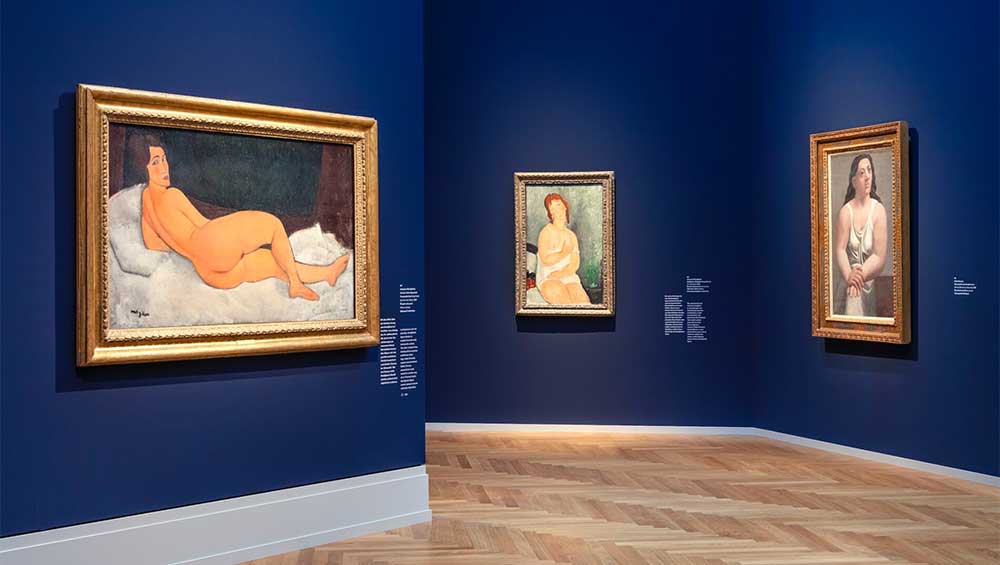
Modigliani: Modern Gazes, installation view, Museum Barberini, Potsdam, 27 April – 18 August 2024. Photo © David von Becker.
Museum Barberini, Potsdam
27 April – 18 August 2024
by SABINE SCHERECK
This exhibition presents two new views on the artist Amedeo Modigliani (1884-1920): first, as a chronicler of the emancipated woman before she became a common sight in the 1920s; second, his work in the context of his contemporaries. Both are very revealing. And there is another angle. Seen within the exhibition landscape of the greater Berlin region, this exhibition at the Museum Barberini might be regarded as a continuation of – or, perhaps, rather a complement to – the exhibition Paris Magnétique shown at the Jewish Museum Berlin last year. It cast light on the École de Paris, the School of Paris, which refers to the international artists who flocked to Paris at the turn of the 20th century and formed the French avant-garde. Many were Jewish, coming from eastern and middle Europe. Modigliani also belonged to this group of artists, but, coming from Italy, he was the great exception. Nevertheless, he too featured in the Jewish Museum’s exhibition, alongside the artists Moïse Kisling and Chaïm Soutine. Portraits of both can now be found here. They were part of Modigliani’s circle of friends in Paris, which he painted, and to whom a section of this exhibition is dedicated – Cosmopolitans: Modigliani’s Circle in Montparnasse.
In this section there is also a portrait of the Polish-Jewish art dealer Léopold Zborowski, who had moved to Paris to study art. Together with his wife, he ran a gallery, which represented Modigliani from 1916 onwards, the year the portrait was made. The following year he arranged Modigliani’s first solo exhibition at Berthe Weill’s gallery. His portrait stands out because of its less-stylised features and warm colours that would not suggest it is by Modigliani.
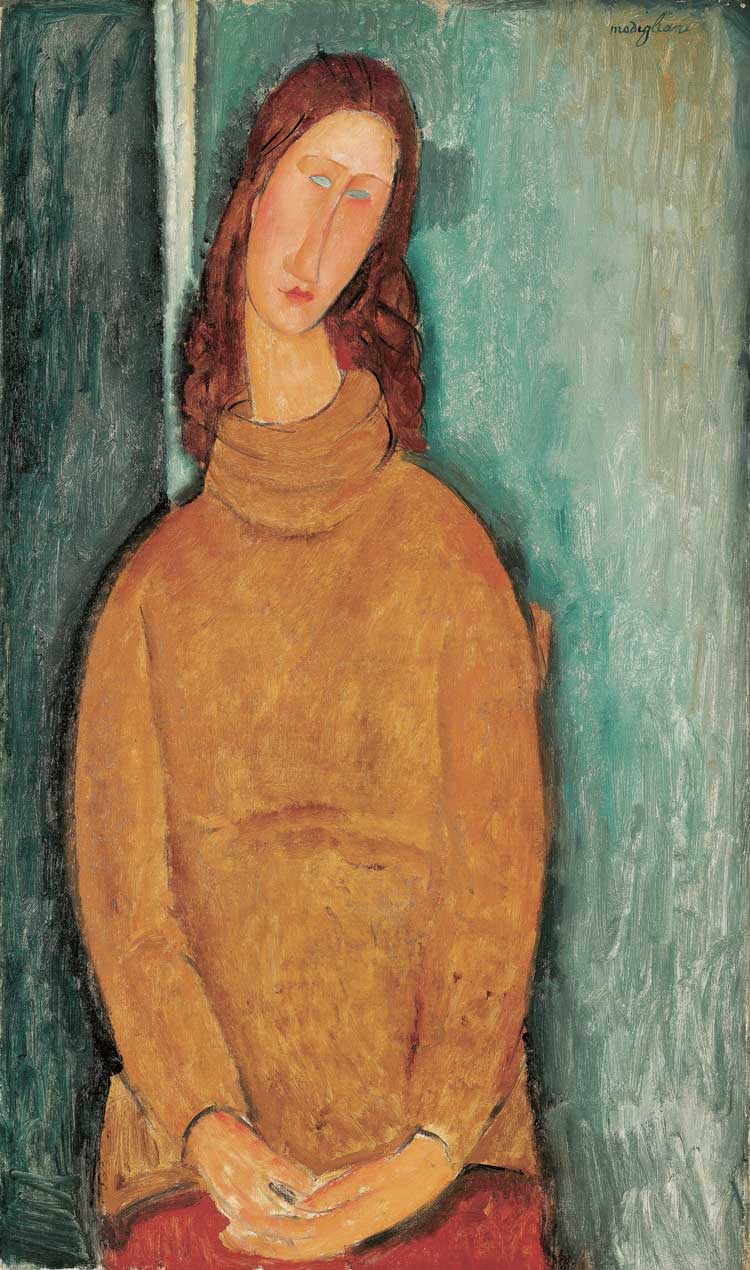
Amedeo Modigliani, Jeanne Hébuterne in a Yellow Sweater, 1919. Oil on canvas, 93 x 54.5 cm. Ohara Museum of Art, Kurashiki.
Warm, even brighter colours make up the portrait Jeanne Hébuterne with Yellow Sweater (1918-19). She wears a corn-yellow jumper that fills a large part of the painting, and her face has a gentle skin tone. This softness of representation is no surprise, considering she was Modigliani’s girlfriend, a 19-year-old art student when they met in 1916. Unlike Zborowski’s portrait, this one is clearly identifiable as a work by Modigliani, with its oval shapes and elongated lines, particularly at the neck. These forms and flat perspectives are reminiscent of the iconographic depictions of the Virgin Mary in the middle ages. Additionally, the stretched limbs, reaching high, echo the gothic style of the 13th century. All this is, however, first revealed midway through the exhibition.
The exhibition itself starts its journey through Modigliani’s cosmos with his arrival in Paris in 1906 and presents 56 of the works that he made in France between 1907 and 1919. Modigliani was 22 when he unpacked his oil paints by the Seine and had just completed his art education in Venice. Having grown up in a French-Italian family in Livorno, he spoke French and was accustomed to cosmopolitan surroundings.
A striking picture in this first section is a portrait of a woman titled The Jewess (1907-08). It is intriguing on several levels. First, it is rare to have someone “outed” as Jewish in this way. Although Paris was a liberal city, the Dreyfus affair had fuelled antisemitism for more than a decade and had only come to an end the year before. Modigliani was Jewish himself and painting this woman was not just a sign of allegiance, but also a personal matter, as he mainly painted those close to him. Although not very religious, the Jewish affiliation gave him a sense of “home”. Second, the atmosphere of the painting. Despite its gloomy cool colours and greenish-purple-blue tones, it has a certain glow and expressionistic touch to it. Her long face and simplified eyes already anticipate Modigliani’s future signature style with oval faces and almond-shaped eyes.
Modigliani’s bohemian life also took him to the revue theatres of Paris where the female dancers inspired him to capture their movements. One such drawing is Columbine in Tutu Holding Fan (1908). Placing his works alongside those made by Henri de Toulouse-Lautrec a decade earlier, such as Confetti (1894), is quite eye-opening. As the dancers move from spectacles in frilly costumes to modern forms of expression, almost naked or in long Greek-style togas, so Modigliani’s lines change. Another room explores the impact of Greek and Egyptian art and non-European cultures, which he encountered in museums in Paris, on his output. Reference is primarily to his sculptures, but the stylised representation of the body, with clear, straight, or only slightly curved lines, which almost adopt a cubist approach, also informs his later portraits and nudes. In this respect, the first half of the exhibition journeys through the influences Modigliani soaked up in Paris, which would go on to shape his unique style. At the same time, having works by Auguste Rodin, Pablo Picasso and Henri Matisse next to Modigliani’s shows how similar they were and simultaneously in which ways the different artists rendered the possibly same source of inspiration into something new.
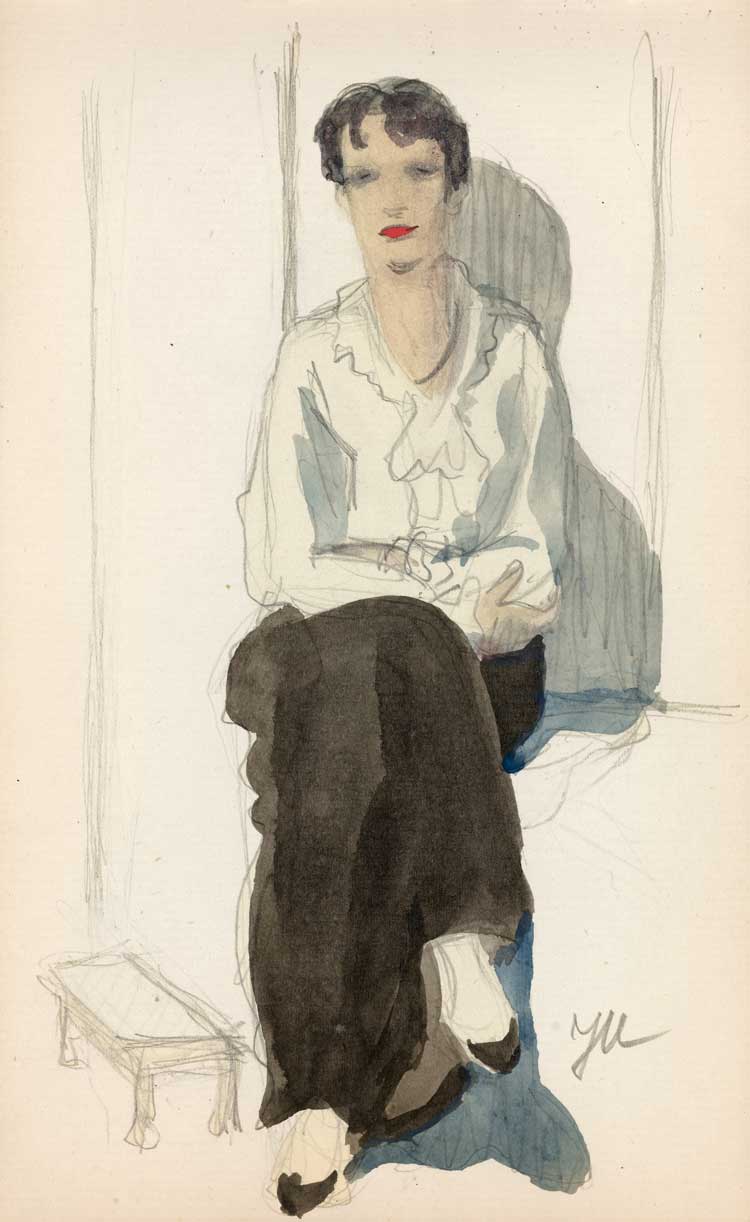
Jeanne Mammen, Sketchbook II, Page 38, 1910–14. Pencil and watercolor on paper, 11 x 17.5 cm. Jeanne-Mammen-Stiftung im Stadtmuseum Berlin. © VG Bild-Kunst, Bonn 2024 / Jeanne-Mammen-Stiftung im Stadtmuseum Berlin / Dorin Alexandru Ionita, Berlin.
The highlight of the show, however, is the room championing La Garçonne: The Masculine Woman. It is a joy to see numerous progressive, independent women, often artists, made visible here, particularly as they were an exception during their own lifetime. Equally intriguing is the thought of having a man, Modigliani, painting them, which demonstrates his interest and care. Usually these women were only portrayed by fellow female artists such as Jeanne Mammen. Born in 1890 in Berlin, Mammen spent her youth in Paris, with some time away from the city to study abroad. An absolute jewel here are her sketchbooks from the years 1910-14. These already show three women with cropped hair. Two of them wear loose, comfortable looking trousers. Were the books undated, the images could easily have been attributed to the 1920s. The young woman with very short black hair and crossed arms and legs, calmly looking straight at the viewer, might even be a woman of today. Back then, in the 1910s, bobbed hair and male attire symbolised independence and freedom from patronising men . It could also code favouring women as lovers.
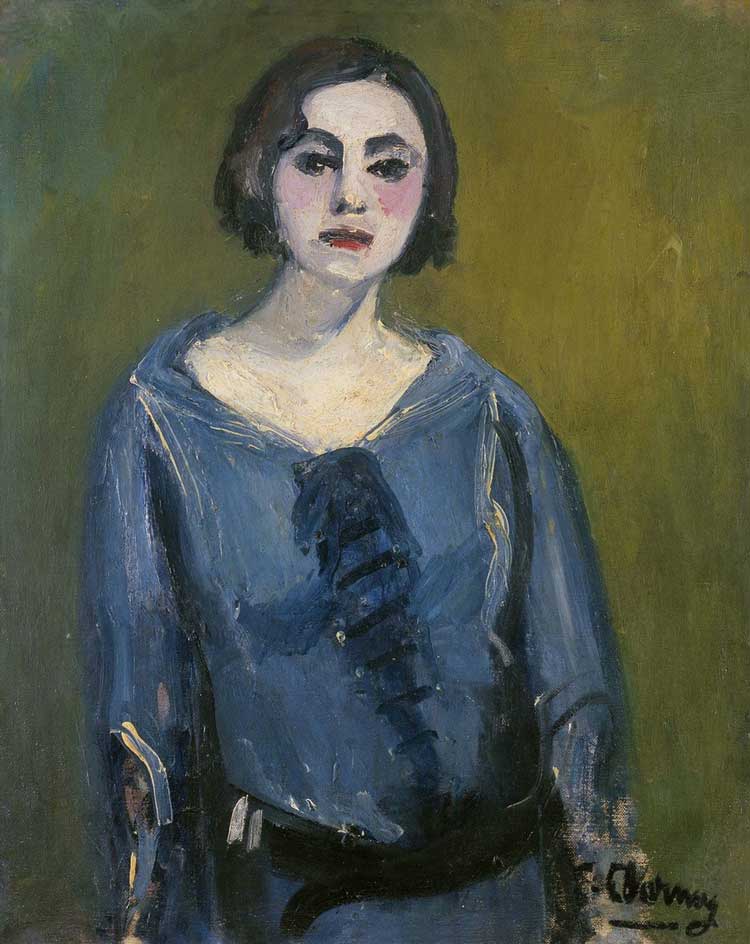
Émilie Charmy, Self-Portrait, 1906–07. Oil on canvas, 81 x 65 cm. Galerie Bernard Bouche, Paris. © VG Bild-Kunst, Bonn 2024 / Galerie Bernard Bouche, Paris.
A new discovery for me is the artist Émilie Charmy (1878-1974). The French avant-garde painter is a fixture in her homeland, but not in northern Germany. In London, the gallery Connaught Brown recently drew attention to her in 2021 when presenting Émilie Charmy – The Female Fauve. Here in Potsdam, Charmy can be seen in a self-portrait from 1906-07, with a rather serious expression. Her short brown hair with a side parting is striking since this revolutionary hairstyle only became gradually acceptable for women in the 1920s. Her dark-blue sailor’s top is equally telling as this masculine-inspired garment was a sign of emancipation.
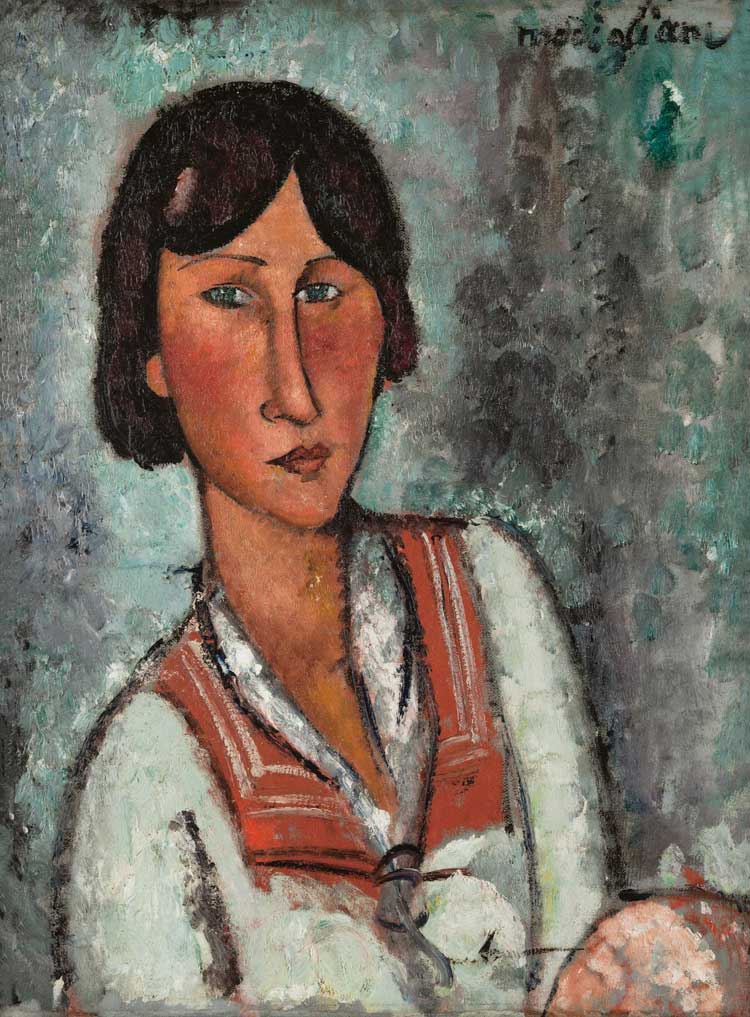
Amedeo Modigliani, Portrait of a Woman, 1918. Oil on canvas, 61 x 46 cm. Denver Art Museum Collection, The Charles Francis Hendrie Memorial Collection. © Denver Art Museum.
Modigliani documented these women, who were ahead of their time, in Portrait of a Girl (Victoria) (1916), Portrait of a Woman (1918) and Young Girl in a Striped Shirt (1917). The woman in Portrait of a Woman also wears a sailor’s shirt: white with a dark-orange collar. Her face has a healthy reddish blush. This picture differs from the others as it not only shows an obviously modern woman, but also, almost tucked away in the bottom right corner of the painting, the top of a baby’s head. It represents a new type of motherhood: a mother with a strong sense of self, rather than one who gives herself up for child and husband. Young Girl in a Striped Shirt is even more arresting. She wears a greyish plain-cut blouse, however the immediate focus of attention is on the black necktie, forming a continuation of the young woman’s long nose. She might almost have the air of a mousy office girl, were it not for her auburn bobbed hair and accentuated red lipstick. Although red hair is often associated with a vivacious persona, her sad eyes speak of a drab and unhappy life. It is not clear who this woman was.
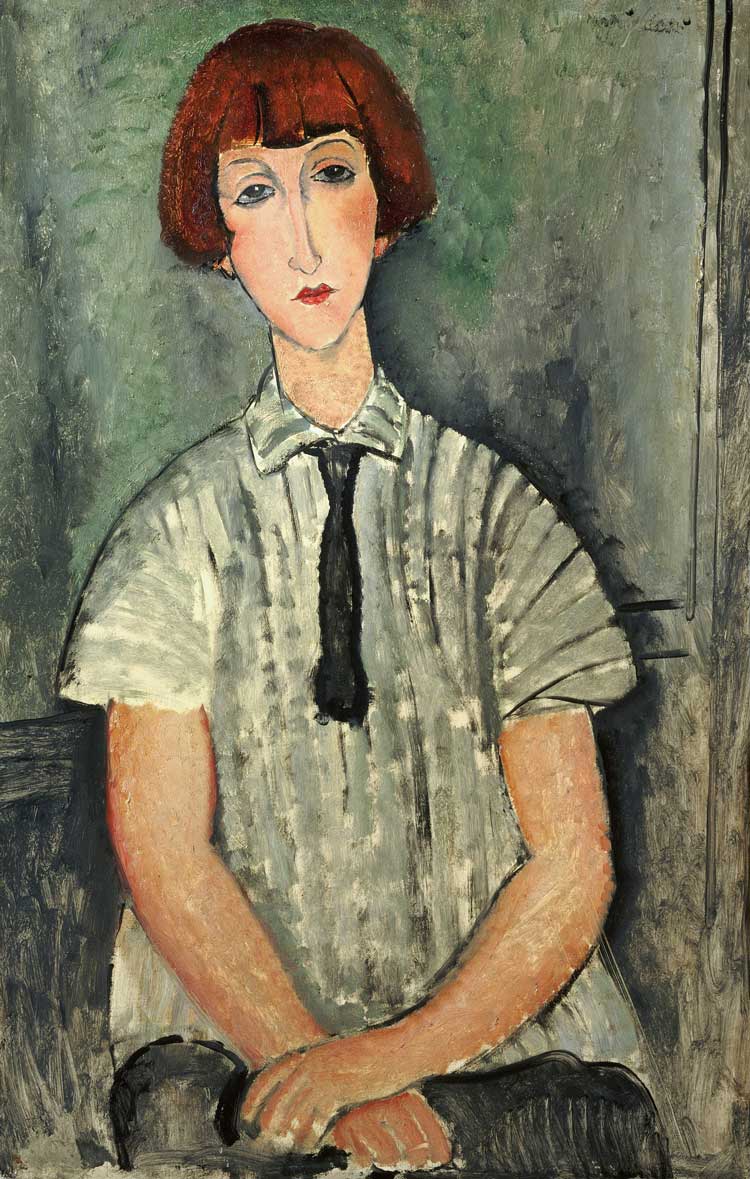
Amedeo Modigliani, Young Girl in a Striped Shirt, 1917. Oil on canvas, 92 x 60 cm. Nahmad Collection. © Christie‘s Images / Bridgeman Images.
It is quite a leap from these modern, boyish young women, practically renouncing femininity, to the nudes in the following room, flaunting all their feminine curves. The fascinating angle here is seeing Modigliani’s works through the prism of the nudes by other artists. For example, the impressive similarities between Modigliani’s Young Woman in a Chemise (1918), Matisse’s Grey Nude with Bracelet (1913/14) and Picasso’s Seated Woman (1921), or Modigliani’s Seated Nude (1917), Ernst Ludwig Kirchner’s Nude on Blue Background (1911) and August Macke’s Nude with Coral Necklace (1910). These images are complemented by nudes painted by women, which have a very different quality to them. Rather than showing just a body with empty eyes, they pick up on the personality of the model. This applies to the nudes by Charmy from the 1920s and even more so to Paula Modersohn-Becker’s Reclining Female Nude (1905-06), which is painted in a very realistic and loving manner. An absolute coup is the positioning of this piece. It may be on a wall to the side, next to Modigliani’s more prominently displayed Reclining Nude on a White Cushion (1917) in the centre, but if you step to the other side of Modersohn-Becker’s large painting, the sightline reveals how neatly the compositions of the two works mirror each other.
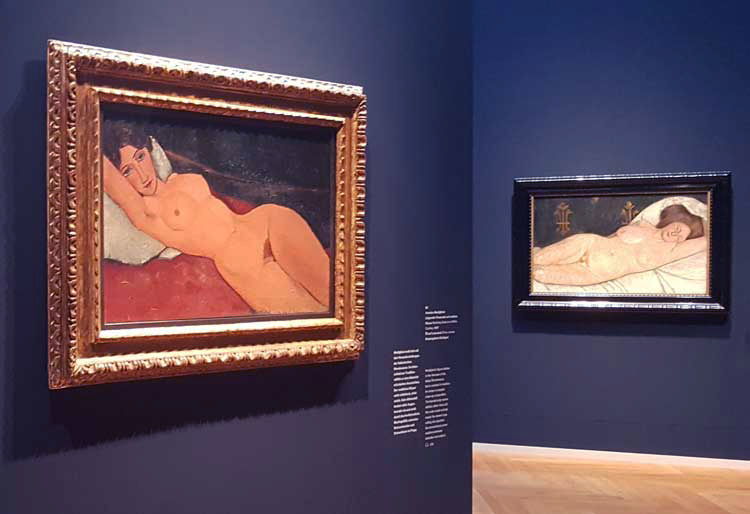
Left: Amedeo Modigliani, Reclining Nude on a White Cushion, 1917, Staatsgalerie Stuttgart; Right: Paula Modersohn-Becker, Reclining Female Nude, 1905/06, Döpfner Collection. Installation view, Modigliani: Modern Gazes, Museum Barberini, Potsdam, 27 April – 18 August 2024. Photo: Sabine Schereck.
The last room takes the visitor to the south of France, where Modigliani sought refuge during the war and also tried to combat the tuberculosis, to which he succumbed in 1920. In the Mediterranean climate, his colours become brighter and more vibrant. A remarkable interaction is that between Modigliani’s The Italian Woman (1918-19) and Gustav Klimt’s Johanna Staude (1917-18). Both paintings have a flat orange background, and both women look straight at the viewer and have dark hair. Apart from the visual proximity of the works, the artists pursued different agendas.
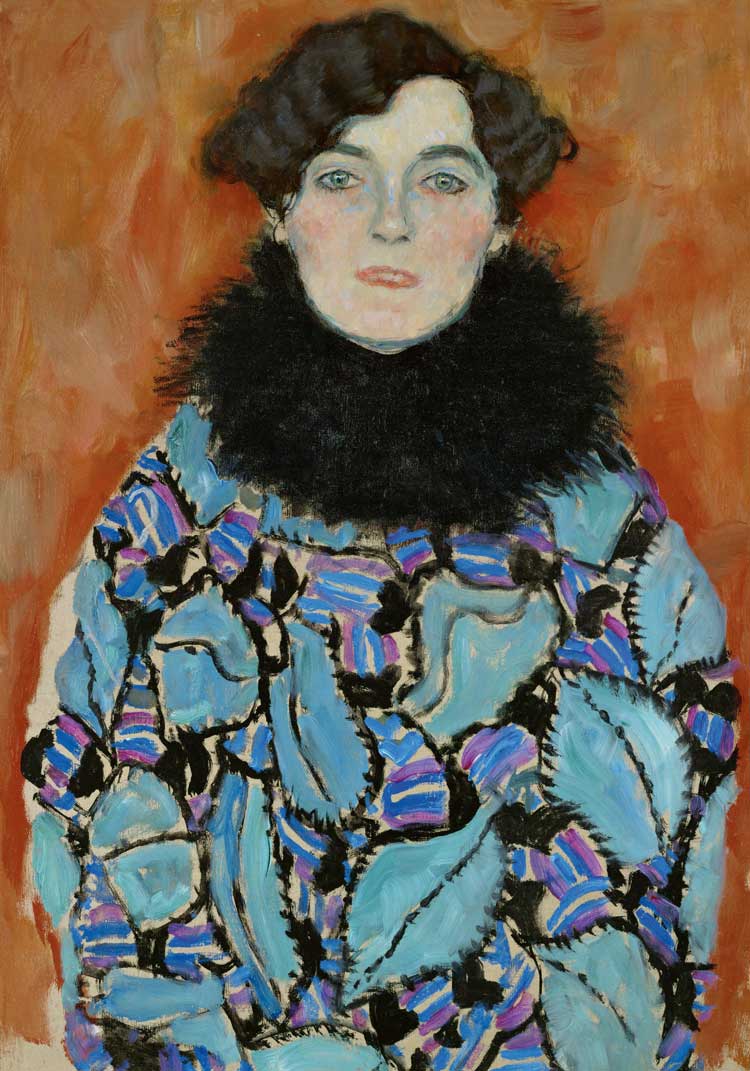
Gustav Klimt. Johanna Staude, 1917/18. Oil on canvas, 70 x 50 cm. Belvedere, Wien. © akg-images / Erich Lessing.
While Klimt often portrayed women from the Viennese bourgeoisie, Modigliani, particularly in the south of France, drew his models from everyday life. So here, Johanna Staude, as a young, modern woman, from a well-to-do artistic family, wearing a flamboyant dress stands in contrast to the mature Italian woman, dressed in plain black, betraying more modest origins. There is no information as to whether the artists knew of each other’s works.
While Klimt’s oeuvre is attributed to art nouveau, this turn-of-the-century style would not necessarily be associated with Modigliani. He was a true modernist – which perhaps seems strange, seeing that he took much inspiration from antiquity and the middle ages. Yet, at the same time, his reduced lines and elongated bodies pre-empt the art deco style which would make its mark in the 1920s and 30s. This becomes very evident in fashion illustrations of the period, such as those by George Barbier and those that feature on the covers of Vogue magazine. Here, this is illustrated with the graphic Couple in Evening Dress (1932) by the Berlin-born fashion illustrator Gerd Harting.
This is the virtue of this exhibition, curated by Ortrud Westheider, director of the Museum Barberini, and Christiane Lange, director of the Staatsgalerie Stuttgart. You do not need to be an admirer of Modigliani to feel enriched after visiting the show. Learning about the various threads, from different periods of art history, that merge in Modigliani’s work leaves you with a much deeper understanding of his idiosyncratic style and art history as a whole. Drawing all these connections to the past, the future and to Modigliani’s European contemporaries is a stunning achievement.